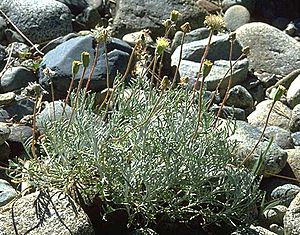Shasta chaenactis facts for kids
Quick facts for kids Shasta chaenactis |
|
|---|---|
 |
|
| Scientific classification | |
| Kingdom: | |
| (unranked): | |
| (unranked): | |
| (unranked): | |
| Order: | |
| Family: | |
| Tribe: | |
| Genus: | |
| Species: |
C. suffrutescens
|
| Binomial name | |
| Chaenactis suffrutescens |
|
The Shasta chaenactis (scientific name: Chaenactis suffrutescens) is a special type of flowering plant. It belongs to the aster family, which includes many well-known flowers like sunflowers and daisies.
This plant is native to the western United States. You can find it growing in parts of California, specifically in Shasta and Trinity Counties. It also grows in Oregon, mainly in Josephine County. It likes to live in coniferous forests and other natural areas within the Klamath Mountains and the southern Cascade Range. Sometimes, it even grows in unique serpentine soils.
What Does it Look Like?
The Shasta chaenactis is a small, spreading plant known as a subshrub. This means it's a bit like a small bush. It grows several stems that stand upright, reaching about 50 centimeters (or 20 inches) tall.
Leaves and Stems
The leaves of this plant are quite interesting. They are several centimeters long and are divided into many smaller parts, almost like tiny branches. These smaller parts are then divided even further! The leaves have a soft, white, woolly coating, which makes them feel like felt.
Flowers and Seeds
The flowers of the Shasta chaenactis grow in a special cluster called a flower head. This head is shaped like a cylinder and sits on top of a strong, upright stem called a peduncle.
Each flower head has many small, white or slightly pink flowers inside. These are called disc florets. They have parts that stick out, which are the anthers. The flowers also have petal-like parts called corollas. Even though they look like they have "rays" (like the petals of a daisy), they don't have true ray florets.
After the plant flowers, it produces a fruit called an achene. This achene is over a centimeter long. It includes a feathery or scaly top part called a pappus, which helps the seeds fly away in the wind.

